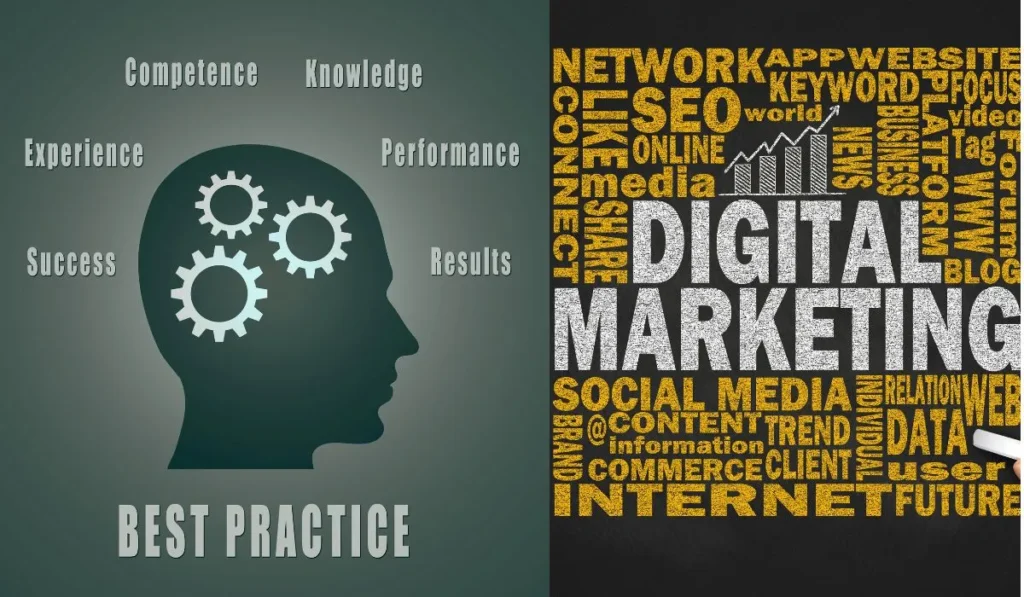Are you struggling to generate leads or sales through your digital marketing efforts? With the ever-changing digital landscape, it can be overwhelming to keep up with the latest trends and strategies. However, by implementing best practices in digital marketing, you can optimize your campaigns and see significant results. In this article, we’ll cover everything you need to know about the best practices in digital marketing, from SEO to social media and email marketing.
Table of Contents
ToggleWhat are the Best Practices in Digital Marketing?
Before diving into specific tactics, let’s define what we mean by best practices in digital marketing. Simply put, it refers to the most effective and efficient ways to promote your brand, products, or services online. The goal is to reach your target audience, engage them, and convert them into customers. Best practices in digital marketing are based on data-driven insights and proven methods that work across industries and channels.
Importance of Best Practices in Digital Marketing
Why should you care about implementing best practices in digital marketing? The answer is simple: it can make or break your online success. Without a solid strategy and tactics, you’ll likely waste your time, money, and effort on ineffective campaigns. On the other hand, by following the best practices, you can:
- Improve your search engine rankings
- Drive more traffic to your website
- Increase your social media engagement
- Build your email list and nurture leads
- Boost your sales and revenue
Now that you know why best practices in digital marketing matter, let’s explore the top tactics you should be using.
Best Practices in Search Engine Optimization (SEO)
SEO is the process of optimizing your website and content to rank higher in search engine results pages (SERPs). It’s a crucial aspect of digital marketing, as it can bring in organic traffic that’s highly targeted and valuable. Here are some best practices in SEO:
Conduct Keyword Research
Keyword research is the foundation of SEO. It involves identifying the most relevant and high-volume keywords that your target audience is searching for. By using tools like Google Keyword Planner or SEMrush, you can find the right keywords to target in your content.
Optimize On-page Elements
On-page optimization refers to optimizing your website’s pages and content to improve their relevance and quality. This includes:
- Writing compelling meta titles and descriptions that include your target keywords
- Using header tags (H1, H2, H3) to structure your content
- Including internal and external links to authoritative sources
- Optimizing your images with alt tags and descriptive file names
Build High-Quality Backlinks
Backlinks are links from other websites that point to your site. They’re important because they signal to search engines that your content is valuable and authoritative. To build high-quality backlinks, you can:
- Guest post on relevant blogs or websites
- Reach out to influencers or bloggers in your niche for collaborations
- Participate in online communities and forums
- Create high-quality content that naturally attracts backlinks
Best Practices in Social Media Marketing
Social media marketing involves promoting your brand or content on social media platforms like Facebook, Instagram, Twitter, and LinkedIn. It’s a powerful way to connect with your audience and build brand awareness. Here are some best practices in social media marketing:
Know Your Audience
To effectively engage your audience on social media, you need to understand their needs, interests, and behaviors. Use tools like Facebook Audience Insights or Twitter Analytics to gather insights about your followers. Then, tailor your content and messaging to resonate with them.
Create Compelling Visuals
Social media is a visual medium, so it’s important to create eye-catching and relevant visuals that capture your audience’s attention. This includes:
- Using high-quality images and videos
- Incorporating your brand colors
Use Hashtags
Hashtags are a way to categorize and organize content on social media. They can help you reach a wider audience and join relevant conversations. When using hashtags, make sure they’re relevant to your content and not overused.
Engage and Interact with Your Audience
Social media is a two-way conversation, so it’s important to engage with your audience and respond to their comments and messages. This can help you build relationships, increase loyalty, and gather feedback.
Best Practices in Email Marketing
Email marketing involves sending targeted and personalized emails to your subscribers or customers. It’s a cost-effective and high-ROI tactic that can help you nurture leads, build relationships, and drive sales. Here are some best practices in email marketing:
Build a Quality Email List
The success of your email marketing campaigns depends on the quality of your email list. You should focus on building a list of subscribers who have opted in and are interested in your content. Avoid buying email lists or spamming people.
Segment and Personalize Your Emails
Segmentation and personalization are key to the effectiveness of your email campaigns. By segmenting your list based on demographics, behavior, or interests, you can send targeted and relevant messages. Personalization can include using the subscriber’s name, location, or previous purchases in your emails.
Use Compelling Subject Lines and Content
Your subject line is the first thing your subscribers will see, so it’s important to make it attention-grabbing and relevant. Your content should be valuable, informative, and engaging, with a clear call-to-action.
Best Practices in Content Marketing
Content marketing is the practice of creating and sharing valuable and relevant content to attract and retain a target audience. It can take many forms, including blog posts, videos, infographics, and ebooks. Here are some best practices in content marketing:
Develop a Content Strategy
A content strategy is a plan for creating and distributing content that aligns with your business goals and target audience. It should include:
- Your brand voice and messaging
- Your content formats and topics
- Your distribution channels and frequency
- Your metrics and goals
Create High-Quality and Valuable Content
Your content should be of high quality and provide value to your audience. This can include solving their problems, answering their questions, or entertaining them. Use data and research to inform your content ideas and make sure they align with your strategy.
Promote Your Content
Creating great content is only half the battle. You also need to promote it effectively to reach your audience. This can include:
- Sharing your content on social media
- Emailing it to your subscribers
- Guest posting on relevant websites
- Running paid promotion on social media or search engines
Best Practices in Conversion Rate Optimization (CRO)
Conversion rate optimization (CRO) is the practice of optimizing your website or landing pages to increase the percentage of visitors who take a desired action, such as filling out a form or making a purchase. Here are some best practices in CRO:
Use Clear and Compelling Calls-to-Action (CTAs)
Your CTAs should be easy to find and use action-oriented language that motivates visitors to take action. Use contrasting colors and whitespace to make them stand out.
Test and Optimize Your Pages
Testing and optimizing your pages can help you identify what’s working and what’s not. This can include:
- A/B testing different versions of your page
- Testing different headlines or images
- Optimizing your page speed and mobile-friendliness
Use Social Proof and Trust Signals
Social proof and trust signals can help build credibility and trust with your visitors. This can include:
- Customer testimonials or reviews
- Trust badges or security seals
- Social media share counts
Best Practices in Search Engine Optimization (SEO)
Search engine optimization (SEO) is the practice of optimizing your website and content to rank higher in search engine results pages (SERPs). Here are some best practices in SEO:
Conduct Keyword Research
Keyword research involves identifying the search terms your target audience is using and optimizing your content accordingly. Use keyword research tools and analytics to inform your keyword strategy.
Optimize Your On-page Elements
Your on-page elements include your title tags, meta descriptions, headers, content, and images. Optimize them by:
- Including your target keywords in your title tags and meta descriptions
- Using descriptive and relevant headers (H1, H2, etc.)
- Writing high-quality and unique content
- Using alt tags and optimized file names for your images
Build Quality Backlinks
Backlinks are links from other websites to your website. They signal to search engines that your content is valuable and trustworthy. Build quality backlinks by:
- Creating high-quality and shareable content
- Guest posting on relevant websites
- Building relationships with other website owners and influencers
Best Practices in Paid Advertising
Paid advertising involves paying for ad space on search engines, social media platforms, or other websites. It can be a cost-effective way to reach your target audience and drive conversions. Here are some best practices in paid advertising:
Set Clear Goals and Metrics
Your advertising campaigns should have clear goals and metrics to measure success. These can include:
- Click-through rates (CTR)
- Conversion rates
- Cost per click (CPC)
- Return on investment (ROI)
Use Targeted and Relevant Ads
Your ads should be targeted and relevant to your audience. This can include:
- Using audience targeting options, such as demographics or interests
- Creating ad variations for different segments
- Using ad copy and images that align with your landing page
Monitor and Optimize Your Campaigns
Monitoring and optimizing your campaigns can help you identify what’s working and what’s not. This can include:
- Tracking your ad performance and metrics
- Adjusting your targeting and bidding strategies
- Testing different ad variations and landing pages
Best Practices in Social Media Marketing
Social media marketing involves promoting your brand and content on social media platforms, such as Facebook, Instagram, and Twitter. It can help you increase brand awareness, engagement, and loyalty. Here are some best practices in social media marketing:
Choose the Right Platforms
Not all social media platforms are created equal. You should choose the platforms that are most relevant to your target audience and align with your goals. This can include:
- Facebook for B2C businesses and brand awareness
- LinkedIn for B2B businesses and thought leadership
- Instagram for visual and lifestyle-oriented content
Create and Share Valuable Content
Your social media content should be valuable and relevant to your audience. This can include:
- Sharing your blog posts, videos, or infographics
- Creating social media-exclusive content, such as polls or stories
- Curating and sharing industry news and trends
Engage and Interact with Your Audience
As with email marketing, engaging and interacting with your social media audience is crucial. This can include:
- Responding to comments and messages
- Running social media contests or giveaways
- Hosting live events or webinars
Best Practices in Mobile Marketing
Mobile marketing involves reaching and engaging with your audience through mobile devices, such as smartphones and tablets. It’s becoming increasingly important as mobile usage continues to grow. Here are some best practices in mobile marketing:
Design for Mobile-first
Your website and content should be designed with mobile devices in mind. This can include:
- Using responsive design that adjusts to different screen sizes
- Simplifying your navigation and content layout
- Optimizing your page load speed
Use SMS and Push Notifications
SMS and push notifications can be effective ways to reach your mobile audience directly. This can include:
- Sending targeted SMS messages to promote special offers or updates
- Using push notifications to remind users of abandoned carts or upcoming events
- Providing value-added content or rewards for opting in to notifications
Leverage Location-based Marketing
Location-based marketing involves targeting your audience based on their physical location. This can include:
- Using geofencing to send notifications or offers to users within a specific location
- Using beacon technology to send personalized messages or promotions to users in-store
- Leveraging social media to target users based on their check-ins or location data
Best Practices in Email Marketing
Email marketing involves sending targeted and personalized messages to your audience through email. It can help you nurture leads, drive conversions, and build brand loyalty. Here are some best practices in email marketing:
Segment and Personalize Your Emails
Segmenting your email list and personalizing your messages can improve engagement and conversions. This can include:
- Using subscriber data to segment your list by demographics, behavior, or interests
- Personalizing your emails with dynamic content or personalization tokens
- Creating triggered emails based on user actions or behavior
Optimize Your Email Content and Design
Your email content and design should be optimized for readability, engagement, and conversions. This can include:
- Using attention-grabbing subject lines and preheaders
- Including clear and compelling calls-to-action (CTAs)
- Using responsive design that adjusts to different screen sizes
Measure and Improve Your Results
Measuring and improving your email marketing campaigns can help you optimize your strategy and achieve better results. This can include:
- Tracking your open rates, click-through rates, and conversion rates
- A/B testing different subject lines, CTAs, or content variations
- Analyzing your email data to identify trends and opportunities
Conclusion
Digital marketing is a constantly evolving field
that requires a strategic and data-driven approach. By following the best practices in digital marketing, you can improve your visibility, reach your target audience, and achieve your business goals. Conducting research, optimizing your on-page elements, building quality backlinks, setting clear goals and metrics, using targeted and relevant ads, monitoring and optimizing your campaigns, choosing the right social media platforms, creating and sharing valuable content, engaging and interacting with your audience, designing for mobile-first, using SMS and push notifications, leveraging location-based marketing, segmenting and personalizing your emails, optimizing your email content and design, and measuring and improving your results are all essential components of a successful digital marketing strategy.
By understanding your audience, staying up-to-date with industry trends, and continuously analyzing and optimizing your campaigns, you can stay ahead of the competition and achieve long-term success in digital marketing.
What are the best practices in digital marketing?
The best practices in digital marketing include conducting research, optimizing your on-page elements, building quality backlinks, setting clear goals and metrics, using targeted and relevant ads, monitoring and optimizing your campaigns, choosing the right social media platforms, creating and sharing valuable content, engaging and interacting with your audience, designing for mobile-first, using SMS and push notifications, leveraging location-based marketing, segmenting and personalizing your emails, optimizing your email content and design, and measuring and improving your results.
Why is keyword research important in SEO?
Keyword research is important in SEO because it helps you understand what your target audience is searching for and optimize your content accordingly. It can also help you identify new opportunities and topics to cover in your content.
What are backlinks in SEO?
Backlinks are links from other websites to your website. They signal to search engines that your content is valuable and trustworthy. Building quality backlinks can improve your search engine rankings and increase your visibility.
How can I measure the success of my advertising campaigns?
You can measure the success of your advertising campaigns by tracking metrics such as click-through rates, conversion rates, cost per click, and return on investment. Setting clear goals and metrics can help you measure and optimize your campaigns more effectively.
What is mobile-first design?
Mobile-first design is an approach to web design that prioritizes the mobile user experience. It involves designing for smaller screens, simplifying navigation and content layout, and optimizing for mobile load speed.
How can I improve my email marketing campaigns?
You can improve your email marketing campaigns by segmenting and personalizing your emails, optimizing your email content and design, and measuring and improving your results. A/B testing different variations and analyzing your email data can also help you identify areas for improvement.


